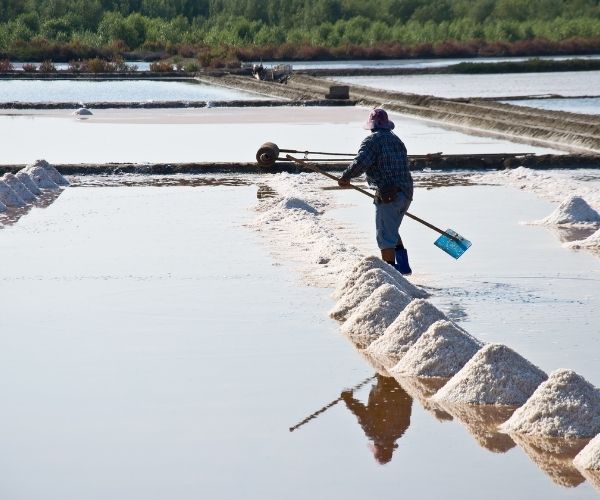Salt is an important thing in the kitchen. If you love food or cooking, you must be very familiar with the look or taste of salt.
Now, you might be wondering, to which category does a salt belong in science?
Is salt an element, compound, or mixture?
Salt (Sodium Chloride) is a compound because it is formed by two types of atoms that chemically combine.
Yes, salt is a compound and NOT a mixture.
This article will talk about why salt is considered a compound. So read along and happy learning!
Is Salt an Element?
No, salt is not an element. There is no such ‘sodium chloride’ element in the periodic table. Salt is made of two different atoms so it’s not a pure element.
Element is a matter that is purely consist of one type of atom.
Some examples of elements are Oxygen (O2), Hydrogen (H2), or Nitrogen (N2).
There are ‘only’ 118 elements on earth. You can see the list on the periodic table.
If you check on the periodic table, there is no such element called ‘SALT’ or ‘sodium chloride’, right?
That’s because salt (Sodium Chloride) is formed by two types of atoms, i.e. Na (sodium) and Cl (Chlorine).
Sodium itself is an element. Chlorine itself is an element. But when they both combine chemically, they formed something called SALT (Sodium Chloride), and it’s not an element.
Is Salt A Compound or Mixture?
So, if it’s not an element, is salt a compound or mixture?
Salt is a compound because it consists of two types of atoms and they both (sodium and chlorine) combine chemically. Additionally, salt (NaCl) always has definite composition across the world.
In Chemistry, something is eligible to be categorized as a compound if the components of the matter are bonded chemically and it has definite composition.
On the contrary, something is called a mixture when the composition is not always the same.
Steel is the example of mixture. It consists of iron and carbon, but it has no definite composition. Different manufacturers can produce different quality of steel with different amount of iron and carbon.
Where Does Salt Comes From?
Salt comes from two sources: the ocean and the land.
The ocean provides salt in its water.
The salt from seawater is extracted using a physical process called EVAPORATION.
The seawater is heated so that the H2O evaporates and leaving the salt.
Did you know? You don’t need expensive chemical tools to perform this process.
You can do this using natural resource (i.e. sunlight).
In fact, that is how the traditional salt farmer conduct the salt extraction.
Typically, they make some EVAPORATION PONDS near the sea. They let seawater enters the shallow pond and let the warm sunlight heat up the seawater so that the H2O (pure water) evaporates, leaving the solid salts to be collected by the salt farmer.

The land also provides salt!
The land salt can be found in salt lakes.

![Is Diamond An Element, Compound, or Mixture? [ANSWERED]](https://dearlearners.com/wp-content/uploads/2021/02/is-diamond-an-element-compound-or-mixture_-768x480.jpg)
![Is Helium An Element, Compound, or Mixture? [ANSWERED]](https://dearlearners.com/wp-content/uploads/2021/02/is-helium-an-element-compound-or-mixture_-768x480.jpg)
![Is Carbon Dioxide An Element, Compound, or Mixture? [ANSWERED]](https://dearlearners.com/wp-content/uploads/2021/01/is-co2-an-element-compound-or-mixture_-768x480.jpg)
![Is Orange Juice An Element, Compound, or Mixture? [ANSWERED]](https://dearlearners.com/wp-content/uploads/2021/02/is-orange-juice-an-element-compound-or-mixture_-768x480.jpg)
![Is Sulfuric Acid An Element, Compound, or Mixture? [ANSWERED]](https://dearlearners.com/wp-content/uploads/2021/02/is-sulfuric-acid-an-element-compound-or-mixture_-768x480.jpg)
![Is Gasoline An Element, Compound, or Mixture? [ANSWERED]](https://dearlearners.com/wp-content/uploads/2021/01/is-GASOLINE-an-element-compound-or-mixture_-768x480.jpg)